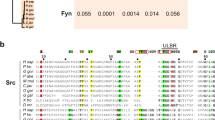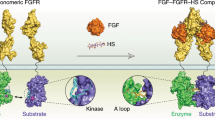Abstract
The structure of a large fragment of the c-Src tyrosine kinase, comprising the regulatory and kinase domains and the carboxy-terminal tail, has been determined at 1.7 Å resolution in a closed, inactive state. Interactions among domains, stabilized by binding of the phosphorylated tail to the SH2 domain, lock the molecule in a conformation that simultaneously disrupts the kinase active site and sequesters the binding surfaces of the SH2 and SH3 domains. The structure shows how appropriate cellular signals, or transforming mutations in v-Src, could break these interactions to produce an open, active kinase.
This is a preview of subscription content, access via your institution
Access options
Subscribe to this journal
Receive 51 print issues and online access
$199.00 per year
only $3.90 per issue
Buy this article
- Purchase on Springer Link
- Instant access to full article PDF
Prices may be subject to local taxes which are calculated during checkout
Similar content being viewed by others
References
Bishop, J. Viral Oncogenes. Cell 42, 23–28 (1985).
Brown, M. T. & Cooper, J. A. Regulation, substrates and functions of sec. Biochim. Biophys. Acta 1287, 121–149 (1996).
Superti-Furga, G. & Courtneidge, S. A. Structure-function relationships in Src family and related protein tyrosine kinases. Bioessays 17, 321–330 (1995).
Pawson, T. Protein modules and signalling networks. Nature 373, 573–580 (1995).
Yu, H. et al. Solution structure of the SH3 domain and Src and identification of its ligand-binding site. Science 258, 1665–1668 (1992).
Musacchio, A., Saraste, M. & Willmanns, M. High-resolution crystal structures of tyrosine kinase SH3 domains complexed with proline-rich peptides. Nature Struct. Biol. 1, 546–551 (1994).
Ren, R., Mayer, B. J., Cicchetti, P. & Baltimore, D. Identification of a ten amino acid proline-rich SH3 binding site. Science 259, 1157–1161 (1993).
Mayer, B. J., Jackson, P. K. & Baltimore, D. The noncatalytic src homology region 2 segment of abl tyrosine kinase binds to tyrosine-phosphorylated cellular proteins with high affinity. Proc. Natl Acad. Sci. USA 88, 627–631 (1991).
Songyang, Z et al. SH2 domains recognize specific phosphopeptide sequences. Cell 72, 767–778 (1993).
Waksman, G., Shoelson, S. E., Pant, N., Cowburn, D. & Kuriyan, J. Binding of a high affinity phosphotyrosyl peptide to the Src SH2 domain: crystal structures of the complexed and peptide-free forms. Cell 72, 779–790 (1993).
Eck, M. J., Shoelson, S. E. & Harrison, S. C. Recognition of a high-affinity phosphotyrosyl peptide by the Src homology-2 domain of p56lck. Nature 362, 87–91 (1993).
Takeya, T. & Hanafusa, H. Structure and sequence of the cellular gene homologous to the RSV src gene and the mechanism for generating the transforming virus. Cell 32, 881–890 (1983).
Hunter, T. A tail of two src's: mutatis mutandis. Cell 49, 1–4 (1987).
Nada, S., Okada, M., MacAuley, A., Cooper, J. A. & Nakagawa, H. Cloning of a complementary DNA for a protein-tyrosine kinase that specifically phosphorylates a negative regulatory site of p60c-src. Nature 351, 69–72 (1991).
Matsuda, M., Mayer, B. J., Fukui, Y. & Hanafusa, H. Binding of transforming protein, P47gag-crk, to a broad range of phosphotyrosine-containing proteins. Science 248, 1537–1539 (1990).
Roussel, R. R., Brodeur, S. R., Shalloway, D. & Laudano, A. P. Selective binding of activated pp60c-src by an immobilized synthetic phosphopeptide modeled on the carboxyl terminus of pp60c-src. Proc. Natl Acad. Sci. USA 88, 10696–10700 (1991).
Cooper, J. A. & Howell, B. The when and how of Src regulation. Cell 73, 1051–1054 (1993).
Koegl, M., Courtneidge, S. A. & Superti-Furga, G. Structural requirements for the efficient regulation of the Src protein tyrosine kinase by Csk. Oncogene 11, 2317–2329 (1995).
Ellis, B. et al. Purification and characterization of deletional mutations of pp60c-src tyrosine kinase. J. Cell. Biochem. (suppl.) 18B, 276 (1994).
Knighton, D. R. et al. Crystal structure of the catalytic subunit of cyclic adenosine monophosphate-dependent protein kinase. Science 253, 407–414 (1991).
Madhusudan et al. CAMP-dependent protein kinase: crystallographic insights into substrate recognition and phosphotransfer. Protein Sci. 3, 176–187 (1994).
De Bondt, H. L. et al. Crystal structure of cyclin-dependent kinase 2. Nature 363, 595–602 (1993).
Jeffrey, P. D. et al. Mechanism of CDK activation revealed by the structure of a cyclinA-CDK2 complex. Nature 376, 313–320 (1995).
Hubbard, S. R., Wei, L., Ellis, L. & Hendrickson, W. A. Crystal structure of the tyrosine kinase domain of the human insulin receptor. Nature 372, 746–754 (1994).
Mohammadi, M., Schlessinger, J. & Hubbard, S. R. Structure of the FGF receptor tyrosine kinase domain reveals a novel autoinhibitory mechanism. Cell 86, 577–587 (1996).
Johnson, L. N., Noble, M. E. & Owen, D. J. Active and inactive protein kinases: structural basis for regulation. Cell 85, 149–158 (1996).
Kato, J. Y. et al. Amino acid substitutions sufficient to convert the nontransforming p60c-src protein to a transforming protein. Mol. Cell. Biol. 6, 4155–4160 (1986).
Potts, W. M., Reynolds, A. B., Lansing, T. J. & Parsons, J. T. Activation of pp60c-src transforming potential by mutations altering the structure of an amino terminal domain containing residues 90-95. Oncogene Res. 3, 343–355 (1988).
Superti-Furga, G., Fumagalli, S., Koegl, M., Courtneidge, S. A. & Draetta, G. Csk inhibition of c-Src activity requires both the SH2 and SH3 domains of Src. EMBO J. 12, 2625–2634 (1993).
Levy, J. B. & Brugge, J. S. Biological and biochemical properties of the c-src+ gene product overexpressed in chicken embryo fibroblasts. Mol. Cell. Biol. 9, 3332–3341 (1989).
Feng, S., Chen, J. K., Yu, H., Simon, J. A. & Schreiber, S. L. Two binding orientations for peptides to the Src SH3 domain: development of a general model for SH3-ligand interactions. Science 266, 1241–1247 (1994).
Lim, W. A., Richards, F. M. & Fox, R. O. Structural determinants of peptide-binding orientation and of sequence specificity in SH3 domains. Nature 372, 375–379 (1994).
Eck, M. J., Atwell, S. K., Shoelson, S. E. & Harrison, S. C. Structure of the regulatory domains of the Src-family tyrosine kinase Lck. Nature 268, 764–769 (1994).
Kuriyan, J. & Cowburn, D. Modular peptide recognition domains in eukaryotic signaling. Annu. Rev. Biophys. Biomol. Struct. (in the press).
Payne, G., Shoelson, S. E., Gish, G. D., Pawson, T. & Walsh, C. T. Kinetics of p56lck and p60src Src homology 2 domain binding to tyrosine-phosphorylated peptides determined by a competition assay or surface plasmon resonance. Proc. Natl Acad. Sci. USA 90, 4902–4906 (1993).
Yamagushi, H. & Hendrickson, W. A. Structural basis for activation of the human lymphocyte kinase Lck upon tyrosine phosphorylation. Nature 384, 484–489 (1996).
Sicheri, F., Moarefi, I. & Kuriyan, J. Nature 385, 602–609 (1997).
Boerner, R. J. et al. Correlation of the phosphorylation states of pp60 c-src with tyrosine kinase activity: the intramolecular pY530-SH2 complex retains significant activity if Y419 is phosphorylated. Biochemistry 35, 9519–9525 (1996).
Levy, J. B., Iba, H. & Hanafusa, H. Activation of the transforming potential of p60c-src by a single amino acid change. Proc. Natl Acad. Sci. USA 83, 4228–4232 (1986).
Murphy, S. M., Bergman, M. & Morgan, D. O. Suppression of c-Src activity by C-terminal Src kinase involves the c-Src SH2 and SH3 domains: analysis with Saccharomyces cerevisiae. Mol. Cell. Biol. 13, 5290–5300 (1993).
Okada, M., Howell, B. W., Broome, M. A. & Cooper, J. A. Deletion of the SH3 domain of Src interferes with regulation by the phosphorylated carboxyl-terminal tyrosine. Biol. Chem. 268, 18070–18075 (1993).
Erpel, T., Superti-Furga, G. & Courtneidge, S. A. Mutational analysis of the Src SH3 domain: the same residues of the ligand binding surface are important for intra- and intermolecular interactions. EMBO J. 14, 963–975 (1995).
Haystead, C. M., Gregory, P., Sturgill, T. W. & Haystead, T. A. Gamma-phosphate-linked ATP- sepharose for the affinity purification of protein kinases. Rapid purification to homogeneity of skeletal muscle mitogen-activated protein kinase kinase. Eur. J. Biochem. 214, 459–467 (1993).
Otwinowski, Z. in Proceedings of the CCP4 Study Weekend (eds Sawyer, L., Isaacs, N. & Burley, S.) 56–62 (SERC Daresbury Laboratory, Daresbury, UK, 1993).
Kabsch, W. Evaluation of single crystal diffraction data from a position sensitive detector. J. Appl. Crystallogr. 21, 916–924 (1988).
Collaborative Computational Project Number 4. The CCP4 suite: Programs for protein crystallography. Acta Crystallogr. D 50, 760–776 (1994).
Jones, T. A., Bergdoll, M. & Kjeldgaard, M. in Crystallographic Computing and Modeling Methods in Molecular Design (eds Bugg, C. & Ealick, S.) (Springer, NewYork, 1989).
Brunger, A. T. X-PLOR Version 3.0: A System for Crystallography and NMR (Yale University Press, New Haven, CT, 1992).
Lamzin, V. S. & Wilson, K. S. Automated refinement of protein models. Acta Crystallogr. D 49, 129–147 (1993).
Kraulis, P. J. MOLSCRIPT: a program to produce both detailed and schematic plots of protein structures. J. Appl. Crystallogr. 24, 946–950 (1991).
Nicholls, A., Sharp, K. A. & Honig, B. Protein folding and association: insights from the interfacial and thermodynamic properties of hydrocarbons. Proteins Struct. Funct. Genet. 11, 281–296 (1991).
Alexandropoulos, K. & Baltimore, D. Coordinate activation of c-Src by SH3- and SH2-binding sites on a novel p130Cas-related protein, Sin. Genes Dev. 10, 1341–1355 (1996).
Author information
Authors and Affiliations
Rights and permissions
About this article
Cite this article
Xu, W., Harrison, S. & Eck, M. Three-dimensional structure of the tyrosine kinase c-Src. Nature 385, 595–602 (1997). https://doi.org/10.1038/385595a0
Received:
Accepted:
Issue Date:
DOI: https://doi.org/10.1038/385595a0
This article is cited by
-
YES1 as a potential target to overcome drug resistance in EGFR-deregulated non-small cell lung cancer
Archives of Toxicology (2024)
-
An allosteric switch between the activation loop and a c-terminal palindromic phospho-motif controls c-Src function
Nature Communications (2023)
-
Roles of Phosphorylation of N-Methyl-d-Aspartate Receptor in Chronic Pain
Cellular and Molecular Neurobiology (2023)
-
Network pharmacology of apigeniflavan: a novel bioactive compound of Trema orientalis Linn. in the treatment of pancreatic cancer through bioinformatics approaches
3 Biotech (2023)
-
Role of c-Src and reactive oxygen species in cardiovascular diseases
Molecular Genetics and Genomics (2023)
Comments
By submitting a comment you agree to abide by our Terms and Community Guidelines. If you find something abusive or that does not comply with our terms or guidelines please flag it as inappropriate.



